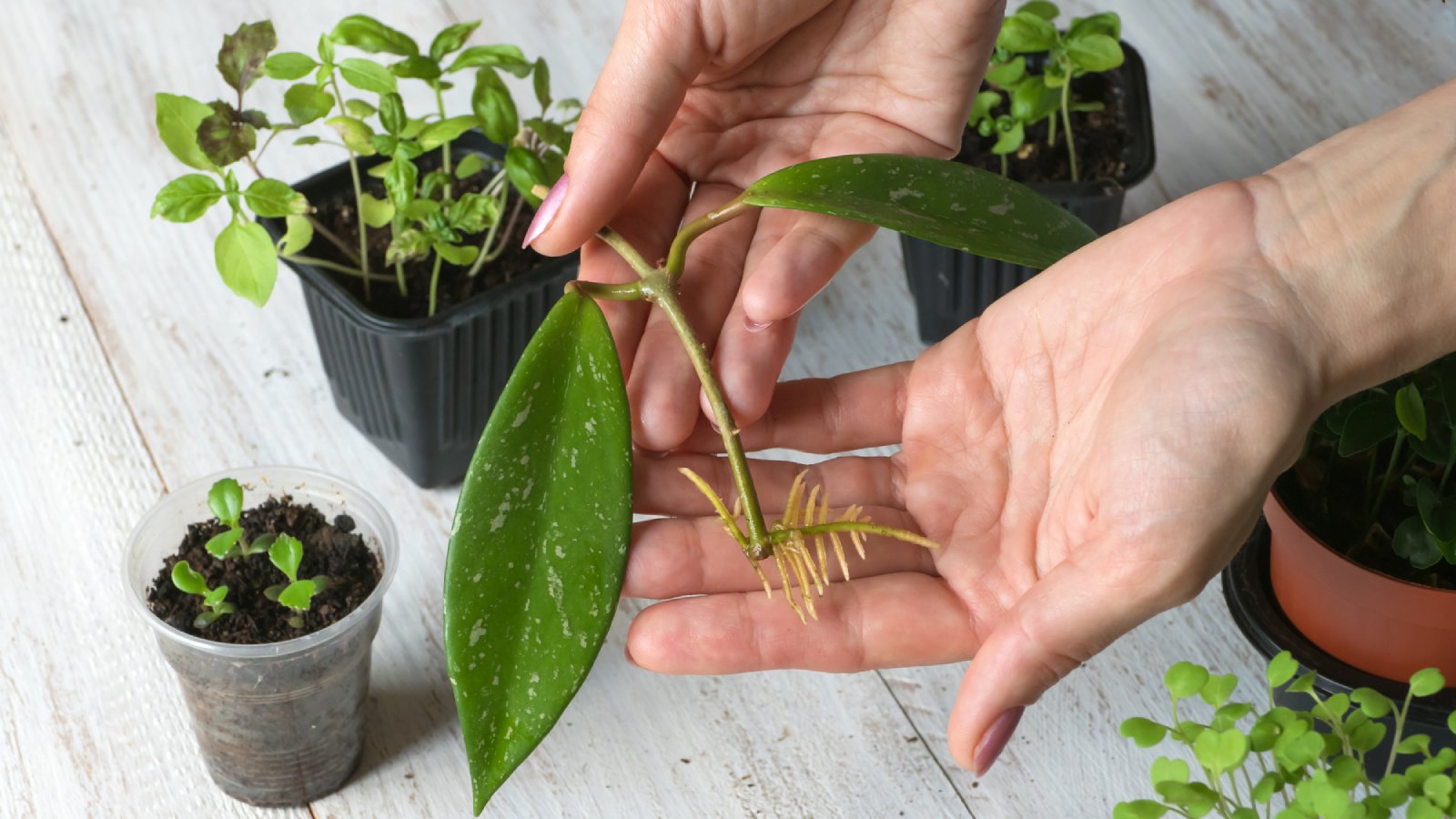How To Propagate Plants
Plants can be propagated by division, cuttings, or seeds.... and it's all free! Get propagating for infinite plants for you and your friends.


If you would like to increase the number of plants you have without buying new ones, you can propagate your existing plants. Some plants are easier than others to propagate, and success may depend on the method you choose. Not all plant propagation is for beginners. Plants can be propagated either sexually, by seed, or asexually by using vegetative parts.
Growing plants from seed is an easy way to get more plants. The seeds can be purchased or collected from plants you already have or from friends, seed-exchanges, or nature (where permissible). The resulting plants may not be identical to the parent plant, but that helps to increase biodiversity.
Growing plants vegetatively is a way to produce an identical plant with the same genetic makeup. Those methods include cuttings, layering, and division. Certain plants can only be reproduced vegetatively.
The Ins And Outs Of Plant Propagation
A plant propagation definition is simply to produce a new plant from an existing one. Who hasn’t rooted or divided a houseplant for a friend or family member? Christmas cactus, airplane plant, pothos, snake plant, jade, and aloe are all examples of plants that are easy to duplicate. One of the fastest annuals to clone is coleus. Those root quickly and easily in a vase of water.
Learning the ins and outs of plant propagation will help to ensure a successful outcome. Here are the basic steps to reproduce plants by seeds, cuttings, layering, and division.
Seeds
Ideally, use seed that is packed for the current year. Older seeds will have a lower germination rate. The seed packet gives instructions for how deep to sow the seeds, at what temperature, and whether the seeds need light for germination. If you don’t have a seed packet, you can find the information online.
Dormant seeds will not germinate till the dormancy is broken. Seeds with a hard seed coat are a type of dormancy because the hard coat prevents water and light penetration. You can soften the seeds by scarification. Two methods are to soak the seeds in warm water or nick the seed coat with a file or sandpaper before sowing.
Sign up for the Gardening Know How newsletter today and receive a free copy of our e-book "How to Grow Delicious Tomatoes".
Another type of dormancy is induced by a chemical in the seed that inhibits germination till the optimal time weatherwise. Those seeds require a moist, cold period or warm period, known as stratification, before they will germinate. For the cold stratification, you can plant the seeds outside in the fall if you live in an area that experiences cold winters.
If it is the wrong time of year or you don’t live where winters are cold you can simulate this chilling period. Mix the seeds with damp sphagnum moss or peat moss in a plastic bag and store it in the refrigerator for about 12 weeks. Then carefully remove the seeds and plant them in pots.
Sowing Indoors
To speed the maturing time, many people choose to start seeds indoors rather than outdoors. Plan on about 4 to 10 weeks before the last spring frost, depending on the plant species. Use sterile containers, seed trays, or biodegradable peat pots filled with commercial seed starting mix or vermiculite.
Sow two or three seeds per cell or container at the depth cited on the seed packet or about 2 times the diameter of the seed. If they need light to germinate, do not cover the seeds. If they need darkness, cover them lightly with soil or vermiculite. Moisten the soil with a fine mist or set the containers in a tray filled with enough water to moisten the soil from below. Then cover the containers with a plastic dome or a plastic sleeve, which will create humidity. When seeds begin to germinate you can remove the cover.
Move the containers to a well-lit location such as a south-facing window or under fluorescent or grow lights for 14 to 16 hours a day. The room temperature should be about 65 to 70 degrees F (18 to 21 C) during the day and about 10 degrees cooler at night.
Keep the soil moist and start fertilizing regularly with a water-soluble fertilizer at half strength. To prevent damping off disease, spray the plants with a fungicide labeled for Rhizoctonia at half strength. When the first true leaves appear, it is time to transplant to larger containers.
Before moving the plants outdoors, start the hardening off process by lowering the temperature and humidity and decreasing the water. Then move them outside to a shady location and gradually increase the sunlight.
Cuttings
Rooting plants from cuttings is easy. Take cuttings with a sharp knife or pruning shears that are disinfected by dipping the tool in rubbing alcohol or a solution of one part bleach to nine parts water. Remove any buds or flowers from the cutting to prevent energy going to flower production instead of root production. The cutting can be dipped in a rooting hormone to increase the success rate. Cuttings can be inserted into rooting media such as sand, vermiculite, potting soil, water, or peat and perlite. Cover them with a plastic bag to increase humidity and retain moisture. Keep the media moist while rooting.
- Leaf cuttings can include a portion of the petiole or not. Place a leaf cutting with up to 1.5 inches (3.8 cm) of petiole upright with petiole down into moist rooting media. Plantlets should form at the base. African violet, peperomia and sedum can be propagated this way.
- In leaf cuttings without the petiole, insert the leaf vertically into the moist medium. The midvein should be below the soil. Examples include snake plant and sedum.
- Cane cuttings are the best way to propagate plants with thick stems such as dumbcane or corn plants. Cut sections 2 to 3 inches (5 to 8 cm) long from an old stem that contain two nodes. You can lay cane cuttings horizontally or vertically in the medium.
- Stem tip cuttings easily root many houseplants or herbaceous perennials. Take a 4 to 6 inch cutting that includes the tip of the stem. Remove the lower leaves. Insert in medium with at least one node below the soil. Water works for many soft stems.
- Stem cuttings are commonly used for woody perennials, shrubs. and trees. The cutting is taken at certain times of the year to reflect softwood, semi-hardwood, and hardwood. Softwood cuttings are succulent growth taken in summer for woody plants such as loropetalum and bayberry. Semi-hardwood is partially mature wood used for evergreen shrubs such as azalea, boxwood, and conifers such as arborvitae. Hardwood cuttings are taken when the plant is dormant in winter and typically used for deciduous shrubs such as forsythia, spirea, or privet.
Layering
The simple layering propagation method is ideal when a branch is hanging low to the ground. Bend it so part of the branch is below the soil and the tip is protruding. Stake it to the ground. To improve the chance of rooting, the underside of the stem can be cut about 2 inches (5 cm) near the bend.
Air layering propagation is often used for houseplants that need rejuvenation. The stem is wounded with a slit held open with a toothpick for a monocot, or a 1-inch (2.5 cm) ring of bark removed for a dicot. (Monocot leaves have parallel veins; dicot leaves have veins that branch out. Monocot flower petals are in threes or multiples of three. Dicot flower petals are in multiples of fours or fives.) Cover the wound with moist sphagnum moss covered with aluminum foil or plastic tied with twist ties or tape. When roots form, the top of the stem can be cut away from the lower stem.
Division
Dividing plants is an easy way to share species like daylily, iris, hosta, liriope, and chrysanthemum. Dig up the clumps and pull them apart into sections, each with foliage. Replant or give away. Bulbs such as tulip and narcissus need to be divided when the flowers decrease. Dig up the clumps and separate the new bulbs from the mother bulbs and replant.

After graduating from Oklahoma State University with a degree in English, Susan pursued a career in communications. In addition, she wrote garden articles for magazines and authored a newspaper gardening column for many years. She contributed South-Central regional gardening columns for four years to Lowes.com. While living in Oklahoma, she served as a master gardener for 17 years.